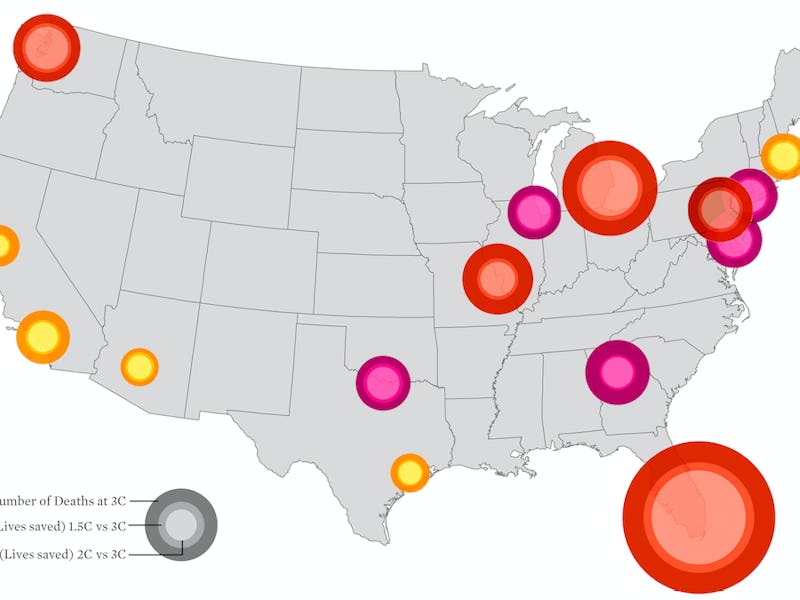Stopping Global Temperature Rise Could Save Hundreds of Lives in 15 US Cities
"Hundreds to thousands of heat-related deaths could be avoided."

A new study shows just how many lives the climate crisis could claim in fifteen vulnerable American cities, when a major heatwave descends.
As temperatures climb, the severity and danger of these heat waves is set to increase dramatically, warn the authors of paper in Science Advances published on Wednesday.
Lead author and University of Bristol research associate Eunice Lo, Ph.D., believes these deaths aren’t inevitable.
In her paper, Lo shows that thousands of lives could be saved in 15 major US cities, but only if we limit global temperature increase to a threshold of no more than 1.5 degrees Celsius by the year 2100. Hitting that goal would save between 110 and 2,720 lives, Lo tells Inverse.
“Hundreds to thousands of heat-related deaths could be avoided per US city per year of extreme heat, if the US and other nations strengthen their climate action to achieve the Paris Climate Agreement goal of 1.5 degree C warming,” says Lo.
"Hundreds to thousands of heat-related deaths could be avoided.
Life-threatening heatwaves strike about once every 30 years, but when they do, they leave damage in their wake. The United States Environmental Protection Agency, which tracks heat-related deaths and hospitalizations in the US over time, estimates that overall, 9,000 Americans have died from heat-related deaths since 1979.
Heating up the planet is our atmosphere, which has for decades been filled with more carbon dioxide than plants can absorb and process via photosynthesis. The air pollution from factories burning fossil fuels, traffic jams, and factory faming is making the situation worse: Humanity passed a grim milestone this month, when the monthly average of atmospheric CO2 reached a new historical record.
US Cities Most Affected by Heat-Related Deaths
Right now, the US isn’t even part of the Paris Agreement because President Donald Trump withdrew the US from it in June 2017. Regardless of US involvement, the planet is already track to blow past the agreed-upon 1.5-degree increase in global temperature, with some models projecting temperature increases between two and three degrees.
The new study suggests that hitting a three-degree increase would have grave consequences for cities across the US. The study infographic below shows the risk of heat-related deaths calculated per 100,000 people across 15 cities if that three-degree mark is hit.
The cities in red will see the greatest number of deaths per 100,000 people if global temperature increases by 3 degrees celsius.
Hitting the 3-degree threshold creates a particularly dire situation for five cities: Miami, Detroit, St. Louis, Seattle, and Philadelphia. Miami will be worst off, with 520 projected heat-related deaths per 100,000 people. That’s more than double that of Detroit, Michigan, which has 204 projected deaths per 100,000. The other cities are listed below.
- St. Louis, Missouri: 113 projected deaths per 100,000 people
- Seattle, Washington: 103 projected deaths per 100,000 people
- Philadelphia, Pennsylvania: 95 projected deaths per 100,000 people
Importantly, these numbers are adjusted for population so that we can compare cities of different sizes. The actual raw number of deaths in larger cities, like Los Angeles or New York, will be far greater than these estimates, even though the proportion of deaths per 100,000 people may seem smaller. This comparison, however, allows us to see how temperature increases impact a variety of smaller cities that might otherwise fly under the radar.
New York, for example, is projected to have 68 deaths per 100,000 in the population if temperature increases by 3 degrees — far less than the projection for Miami, if you’re using the same metric. But keeping in mind that the population of New York is 8.6 million and Miami’s is only about 460,000, more people are ultimately at risk in New York.
It’s a grim picture, no matter how you look at it. Lo adds that populations that are already vulnerable are the ones that will be particularly hard hit.
“Studies have found that elderly people (aged 65+) are more vulnerable to heat than other age groups. Other demographic and socio-economic factors such as poverty also affect vulnerability,” she explains.
But the key thing to remember is that these deaths are preventable, add Lo and her co-authors. For one thing, Miami would see 197 fewer heat-related deaths per 100,000 people if we limit temperature rise to 2 degrees rather than 3 degrees. And if we hit that elusive 1.5 degree mark, the number of lives that could be saved climbs to 272.
There is no question about the negative impact of the climate crisis on the planet, but studies like Lo’s bring home its true cost — thousands of lives that might still be saved, if we act soon.
Abstract:
Current greenhouse gas mitigation ambition is consistent with ~3°C global mean warming above preindustrial levels. There is a clear need to strengthen mitigation ambition to stabilize the climate at the Paris Agreement goal of warming of less than 2°C. We specify the differences in city-level heat-related mortality between the 3°C trajectory and warming of 2° and 1.5°C. Focusing on 15 U.S. cities where reliable climate and health data are available, we show that ratcheting up mitigation ambition to achieve the 2°C threshold could avoid between 70 and 1980 annual heat-related deaths per city during extreme events (30-year return period). Achieving the 1.5°C threshold could avoid between 110 and 2720 annual heat-related deaths. Population changes and adaptation investments would alter these numbers. Our results provide compelling evidence for the heat-related health benefits of limiting global warming to 1.5°C in the United States.